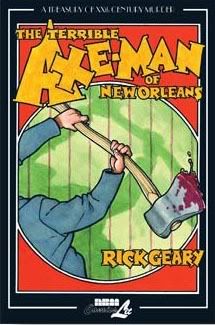| Pop Culture Gadabout | ||
|
Thursday, July 22, 2010 ( 7/22/2010 09:50:00 PM ) Bill S.  “DON’T SCARE ME PAPA.” The twelfth book in Rick Geary’s ongoing series of graphic histories of notorious murders, The Terrible Ax-Man of New Orleans (NBM) charts the two-year reign of terror that held the Big Easy following the first World War. In 1918-19, an axe-wielding serial murderer, primarily focusing on Italian immigrant grocers, attacked victims in their homes, in most cases slaughtering them with their own axes. How the mysterious figure actually gained entry to his preys’ domiciles is itself a mystery: in many of the slayings, a single panel was found to have been pried out of the door, but the resulting opening was deemed too small for an adult to squeeze through. “DON’T SCARE ME PAPA.” The twelfth book in Rick Geary’s ongoing series of graphic histories of notorious murders, The Terrible Ax-Man of New Orleans (NBM) charts the two-year reign of terror that held the Big Easy following the first World War. In 1918-19, an axe-wielding serial murderer, primarily focusing on Italian immigrant grocers, attacked victims in their homes, in most cases slaughtering them with their own axes. How the mysterious figure actually gained entry to his preys’ domiciles is itself a mystery: in many of the slayings, a single panel was found to have been pried out of the door, but the resulting opening was deemed too small for an adult to squeeze through.The assailant was never apprehended and, not surprisingly, his antics sparked a variety of reactions within the frightened community. Geary, as is usual with this series, is as fascinated with the era’s response to its atrocities as he is the crimes themselves -- and in early twentieth century New Orleans he has a milieu ripe with histrionics. When a letter appears in the Times-Picayune, for instance, threatening the lives of any resident who does not “jazz it up” on the night before an Italian holiday, the city becomes host to a night of “Axe-Man Parties.” The event is even later commemorated in a jazz number, “The Mysterious Axe-Man’s Jazz (Don’t Scare Me Papa),” which becomes an instant best-seller. Because the Axe-Man was never captured and his victims were so numerous (12 citizens murdered or injured by an axe, though a few of these attacks don’t completely fit the killer’s m.o.), Geary’s focus proves broader than it did in an outing like his The Murder of Abraham Lincoln. But his eye for the telling period detail remains. (His capture of the victims' homes and shops provides a definite sense of place which can't help adding a little melancholy to the proceedings.) Geary has produced a dozen books focusing on 19th and 20th century true crime, and he doesn’t appear to have exhausted himself yet. Axe-Man benefits from its evocative setting, of course, which the artist lovingly depicts (first ten pages are devoted to a history of New Orleans’ founding) with his trademark intricately lined penwork. As an artist, Geary resembles R. Crumb in the way he broaches caricature with his serious renderings but never fully succumbs to it. The approach adds a lightness to details like the outlandish theories promulgated at the time about the killer’s identity (one has it that the Axe-Man has a Jekyll/Hyde personality, though there is no evidence to back this half-assed profile), while remaining clear and specific about the horrid nature of the murders themselves. As with his earlier examinations, Rick Geary approaches his subject with wit, relish -- and just the right amount of sensationalistic gore. (First published on Blogcritics.) Labels: modern comics # | |
|
|

